“Five fe-eee-eet and we are over and safe”: Cargo Ships and River Boats on the Maroochy, Mooloolah and Noosa Rivers.
By Christina Ealing-Godbold, Research Librarian, Information and Client Services | 31 March 2021
The region we now know as the Sunshine Coast was not easily accessible when it was first opened up to timber felling and agriculture from 1862 to the turn of the century. Have you ever wondered how ancestors made their way to their destinations once they had arrived in Queensland? The Mooloolah and Maroochy Rivers were highways for a myriad of small ships that moved up and down, over the sandbars, connecting the pioneer settlers with their mail and provisions. In return, their produce – timber and fruit, were taken to market. The markets were not only in Brisbane but further afield in Sydney and Melbourne.
Australian road and rail routes were slow to develop for a variety of reasons, including difficult coastal terrain and lack of communication between towns that were often thousands of miles apart. The North Coast railway was opened in 1891 but roads of decent quality took longer, with the Nambour to Maroochydore road not being completed until 1927.
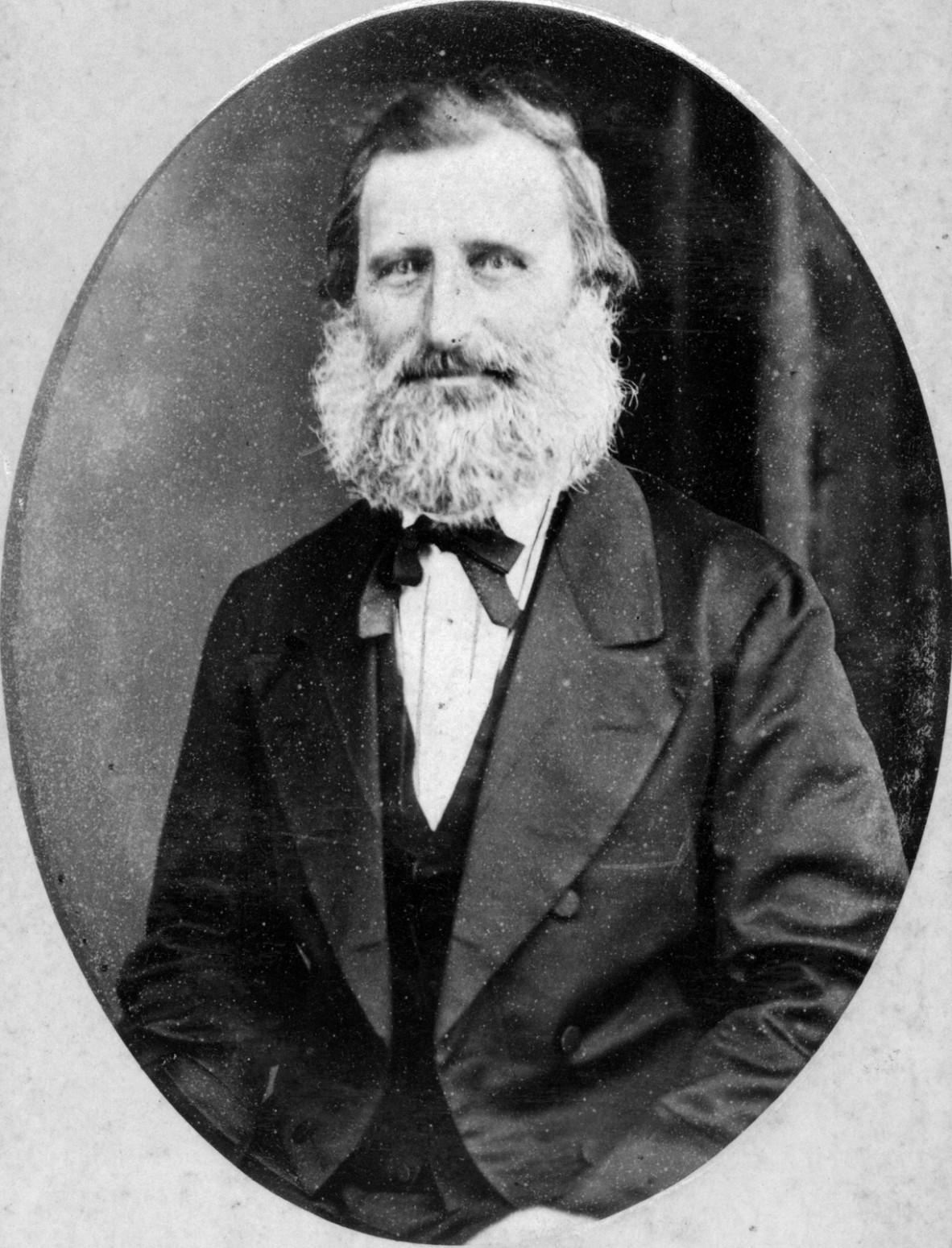
William Pettigrew of Brisbane 1875. John Oxley Library, State Library of Queensland. Negative number: 63572.
“William Pettigrew was a surveyor and farmer who arrived on the "Fortitude" in 1849. In 1853 he erected the first steam sawmill in Brisbane. He was mayor of Brisbane, 1870-1871 and MLC 1877-1894. He owned land at Mooloolah and Alexander Head, which later was subdivided into the township of Mooloolaba.”
In 1864, William Pettigrew began felling cedar, pine and other valuable timber in the upper reaches of the Mooloolah and Maroochy rivers and moving them to Brisbane to his sawmill at William Street on the Brisbane River. Firstly, the logs were rafted downstream to Dunethin Rock. The first ship was the "Tadorna Radjah", a stern-wheeler paddle steamer known locally as “The Dodger” as it could deftly dodge and navigate the sand bars in the river systems.
Twenty years later, Pettigrew constructed "The Tarshaw" using engines from Ayr in Scotland and screw propellers from the Thorneycroft company in Chiswick England. The ship was constructed of good colonial hardwood, tree-nailed, copper-fastened and sheathed with she-pine. The problem for Pettigrew was building a ship with a shallow draft that could make its way over the bar into the Maroochy or Mooloolah rivers. The screw propellers assisted with the turning and provided the agility needed to avoid the sandbanks. Mr Pettigrew needed a draft of no more than 4 foot, 6 inches or the ship would stick fast onto the bar. Smaller ships made the journey further up the creek and rivers with a draft of just 17 inches.
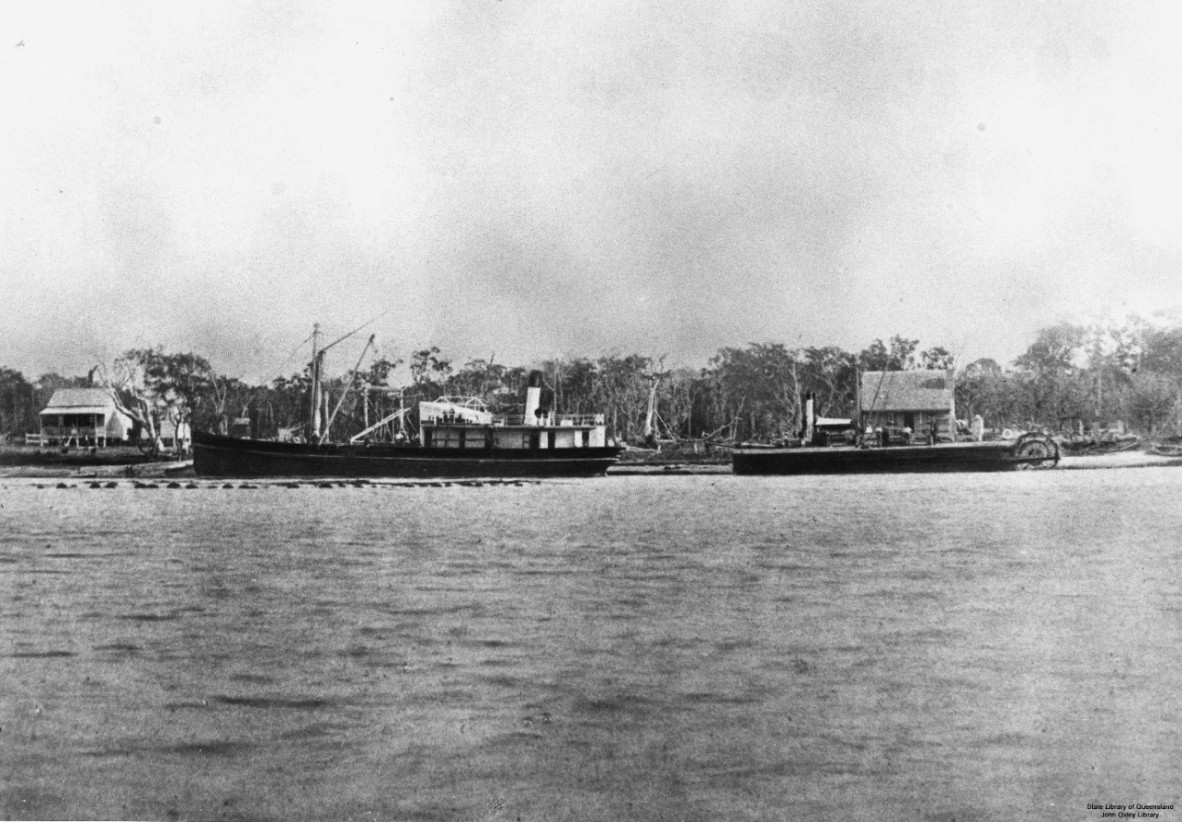
"The Tarshaw" (ship) on the left and the "Tadorna Radjah" (ship) on the right, anchored at Pettigrew's wharf, Maroochydore, 1882; John Oxley Library, State Library of Queensland, Negative number: 4357.
Later Pettigrew added the "Gneering" to his fleet. The three ships worked to open up the Maroochy area to commerce and agriculture. Initially based at Mooloolaba, Pettigrew opened a wharf in the Maroochy River mouth in 1884 and constructed a sawmill on the banks of the Maroochy in 1891. The wharf was located where Wharf Street is now in Maroochydore and the timber depot was in the vicinity of the current day Baden Powell Street. Cotton Tree had become a recreational reserve by the 1920s but prior to 1900, was also the site of much shipping activity and a timber mill. Pettigrew sold his mills and enterprises in 1898. The “Gneering” sank at the Maroochy River Bar and was towed to Goat Island where the hulk was left for the tides to gradually do their work.
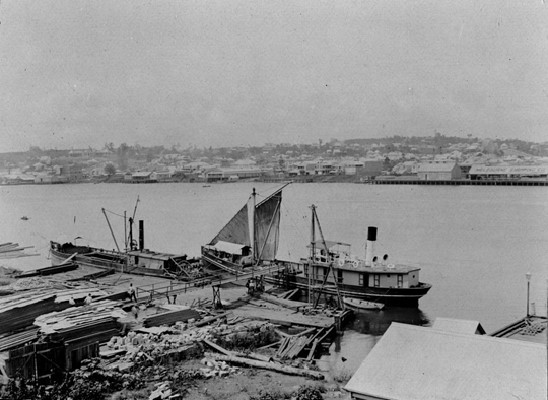
The "Gneering" at Pettigrew’s wharf in Brisbane, ca 1895; John Oxley Library, State Library of Queensland, Negative number: 64740.

Cotton Tree, at the mouth of the Maroochy River, once the scene of much shipping activity for William Pettigrew’s mills.
In the North Coast Advertiser in 1923, an old-timer remembers the journey over the bar in the ship “Tarshaw” in the 1890s. After spending the night in the Bribie passage waiting for the tides and weather to align and running the gauntlet of the Caloundra sandbars, he described the Maroochy (Maroochie) River entry–
One of the sailors had a long pole…as we approached the bar of the Maroochie, he dexterously threw the pole forward…calling eight fe-eee—eet, seven fe-eee—eet, five fe-eee-eet, four fe-eee-eet six inches…and simultaneously a bump as her bottom hit the sand and then the “whirr” as the stern wheel was rapidly revolved…then five fee-ee-eet and we were over and safe.
However, there were many other smaller boats on the rivers and other smaller wharves throughout the creek and river systems of the Sunshine Coast. Punts or small flat-bottomed boats took children to school and helped locals to cross the rivers as well as moving loads of cane and fruit as required on the waterways. Other well-known boats were the “Culgoa”, a regular in the Noosa River and Tewantin waterways as was the tourist boat "Miss Tewantin” and also “Beryl”, a boat owned by Hixteds of Brisbane.
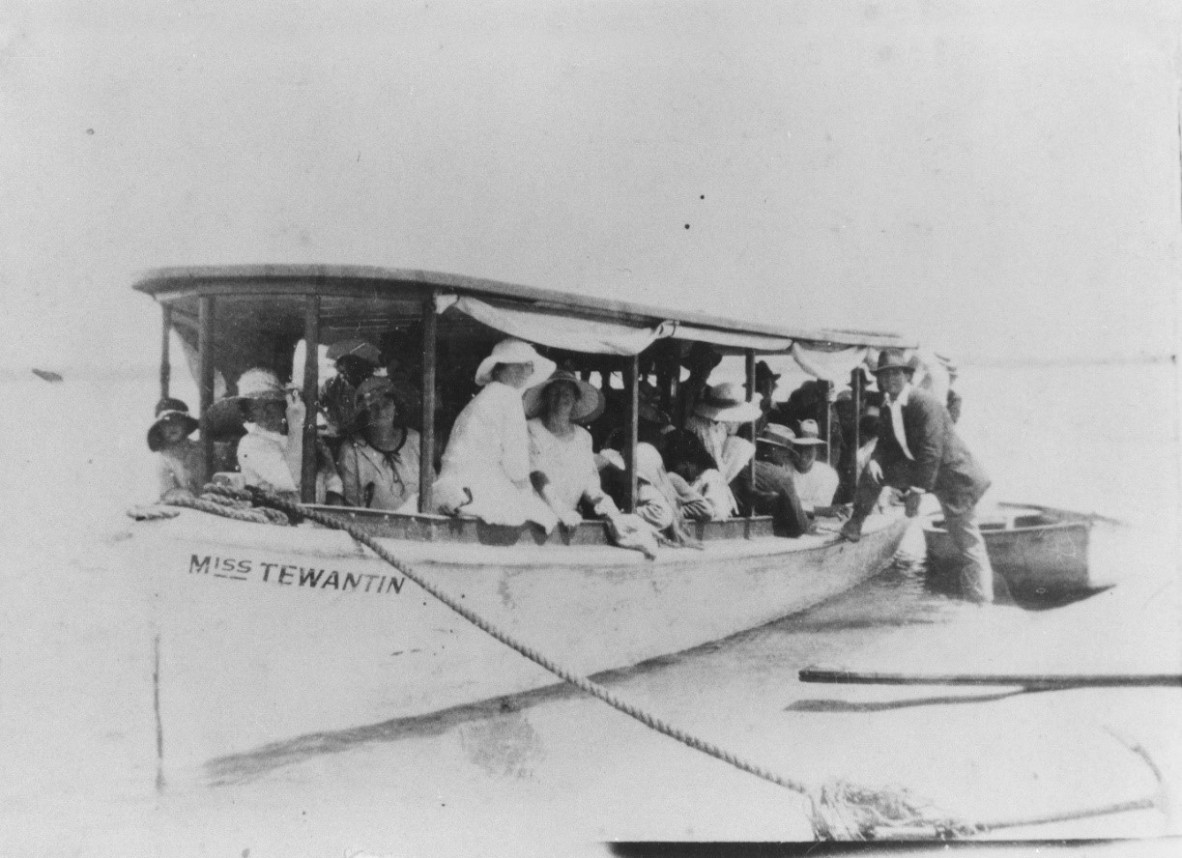
Passengers onboard “Miss Tewantin” on the Noosa River ca.1923; John Oxley Library, State Library of Queensland, Negative number: 45838.
Boating families such as the Coulsons and the O’Connors ran small riverboats up until the 1960s. The Yandina mail boat with the most beautiful name of “Ariel” plied the mail route through the 1950s. "Ariel" was owned and run by Vic Coulsen from his wharf in Yandina. There was a time when boats were the only way to travel from Yandina to Bli Bli or Maroochydore. They carried mail, supplies and passengers, including taking children to school in Yandina.
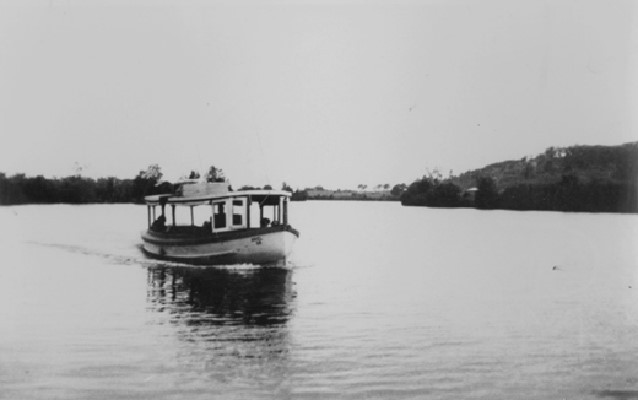
Yandina mail boat, "Ariel", on the Maroochy River, ca. 1954. John Oxley Library, State Library of Queensland. Negative number: 65897
By 1935, it was reported that the road and rail routes had developed so much that the cargo boats were not so necessary. However, produce was still being shipped from the Mooloolah and many of the smaller boats were still used for mail, provisions and school runs up until the 1950s and early 1960s. Other small boats were increasingly used for tourism and fishing, as some still are used for that purpose today.
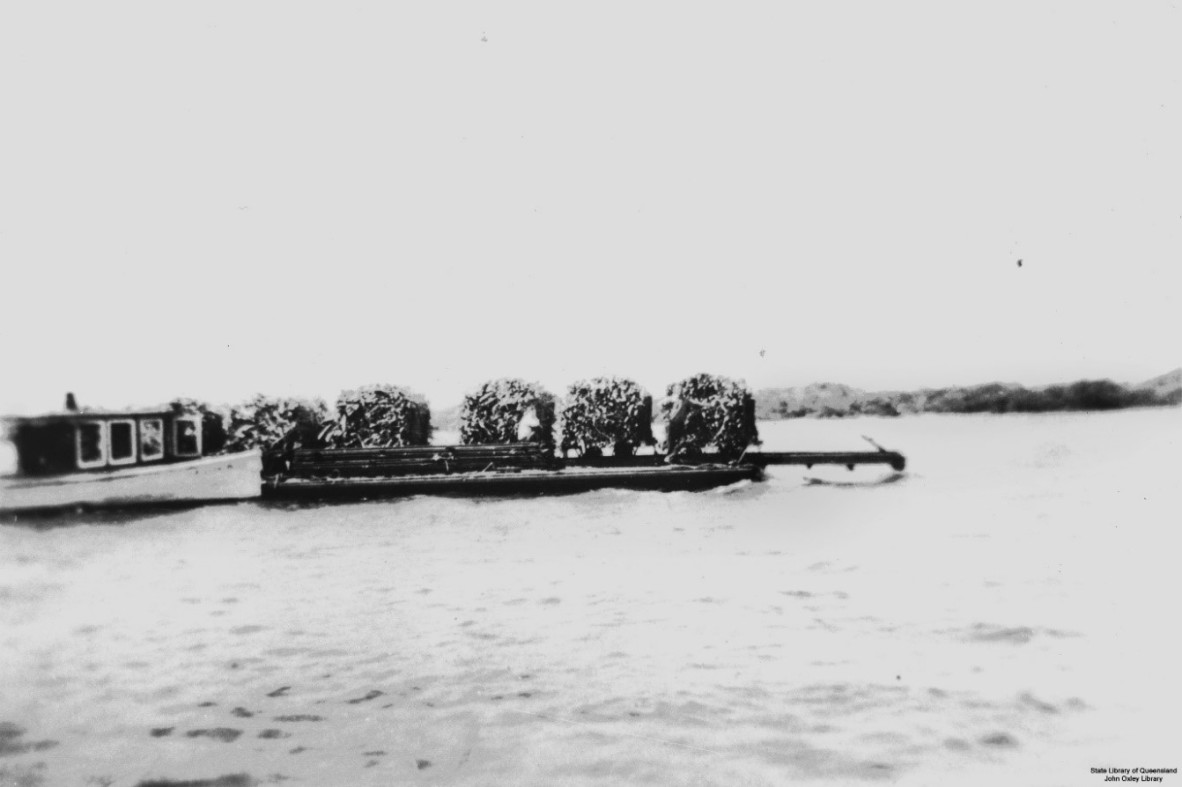
Cane punt bringing sugar cane across Maroochy River, Queensland, to mill; ca.1930-1940; John Oxley Library, State Library of Queensland, Negative number: 51466.
Without the coastal cargo vessels and the river boats, the Sunshine Coast and its hinterland would not have prospered as it did. Coastal rivers and terrain were so difficult to traverse that only the rivers provided the highways and a means of sending the produce to market. The lure of timber (especially cedar) bought William Pettigrew and other timber-getters to the Mooloolah and Maroochy areas in the 1860s. Timber was gold but only if it could reach the markets and the sawmills.
By the turn of the century, when William Pettigrew had sold his timber and milling interests, there was another economic gold – farming bananas, sugar cane, mandarins and other fruit which needed to reach markets. In 1922, it was reported in the Brisbane papers that more than 195 loads of bananas had been sent to Sydney and Melbourne markets from Mooloolaba wharves. Passengers were also provided with transport and mail was delivered to otherwise isolated communities. The key to the operation was to dodge the sandbanks and to make it over the river bars.
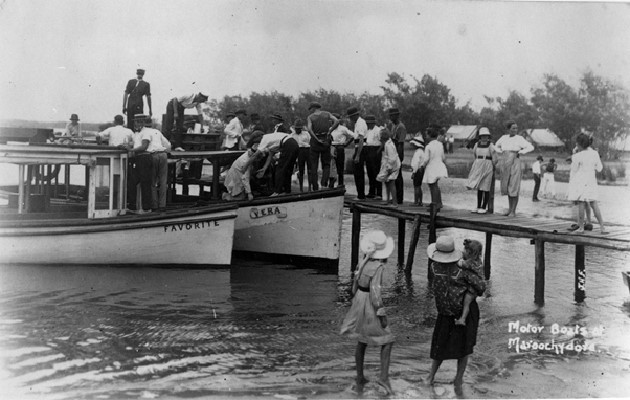
The” Favourite” and “Vera”, small motor-boats used on the Maroochy River, 1918. Negative number: 45123. John Oxley Library, State Library of Queensland.
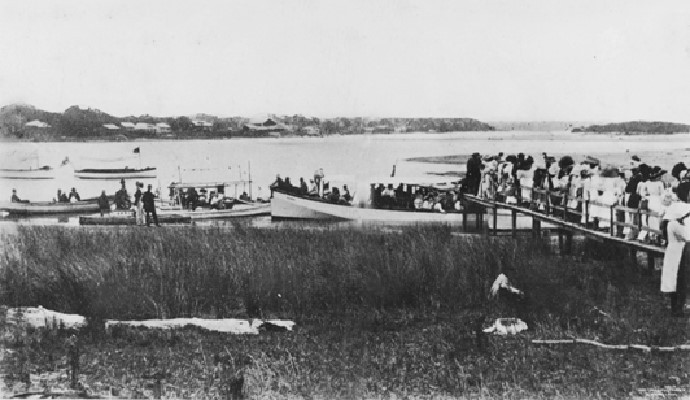
Passengers boarding small boats at a jetty on the Maroochy River, Maroochydore, ca.1912; John Oxley Library, State Library of Queensland, Negative number: 45149.
State Library’s One Search catalogue has many historic digitised images of the Sunshine Coast Rivers and the boats that plied them. Try the following subject headings:
- Rivers -- Queensland – Mooloolaba
- Noosa River (Qld.)
- Maroochy River (Qld)
State Library also has numerous books on Queensland harbours and rivers and the boats in Queensland waters. Some examples are:
- BOOK - Davenport, W. & Queensland. Department of Harbours Marine, 1986. Harbours & marine : port & harbour development in Queensland 1824-1985. Available: Request to access from level 4 (Q 387.1 por ).
- BOOK - Torrance, W., 1988. Motor ships of the thirties / William Torrance. Available: Open Access, level 2 (GSB 386.2209 1988) or request to access from level 4 (Q 386.2209 tor).
- BOOK - Paterson, L., 2002. Wreck-ollections : ships and shipwrecks in Queensland waters / Lance Paterson. Available: Open Access, level 3, Vol.1-3 (FAMHIS 919.43 2002-2018) or open access, level 4, vol.1-4 (REFJ 910.452 PAT).
- BOOK - Woosley, F.C., 1897. Ships and shippers / by Fred. C. Woosley. Available: Request to access from level 4 (RBJ 923.8 WOO ).
- BOOK - Doyle, D.J. & John Burke Limited, 1937. A saga of the sea : being an historical survey of the foundation and progress of the house of John Burke Limited. Available: Request to access from level 4 (P 387.522 DOY ).
Manuscripts
John Oxley Library, level 4, has the William Pettigrew Papers at OM72-69 and OM72-62.
More information
One Search - http://onesearch.slq.qld.gov.au/
Library membership - /get-involved/become-member
Ask us - /plan-my-visit/services/ask-us
Comments
Your email address will not be published.
We welcome relevant, respectful comments.